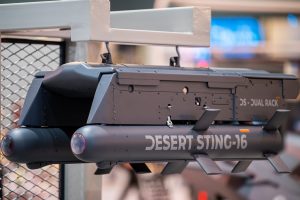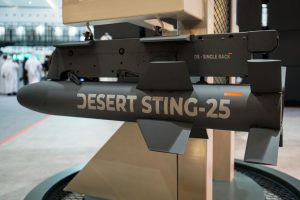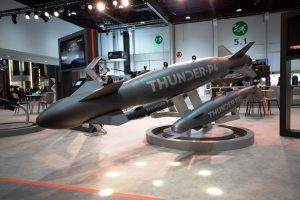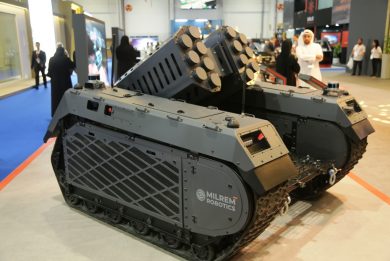
Inside EDGE – Halcon, the group missile house
In the EDGE universe air-to-ground and ground-to-air guided weapons, aka missiles, fall under the responsibility of HALCON, which was formed six years ago. Located in the Tawazun Industrial Park (TIP), HALCON is one of the many defence companies hosted in that facility, together with other EDGE entities as well as with other international companies
Visiting a company always gives a much better insight compared to seeing its products, usually mock-up, on its booth at a major exhibition. Not only it allows to get more detailed information on its products, but it also gives a much better view of production standards and procedures as well as of solutions planned to further increase production rate and improve quality. The best-seller at HALCON, part of EDGE Missiles & Weapons cluster, is the Desert Sting family, of which currently the Desert Sting 16 (DS-16) is in production, while the DS-25 in still in development, and has reached the detailed design phase.

As quick memento, the DS-16 is a 23 kg precision guided glide weapon carrying a 15 kg warhead fitted with impact/height of burst fuse. It is 1,000 mm long, the body has a 129 mm diameter while the wings have a 323 mm span. The basic version is fitted with a GNSS assisted Inertial Navigation System (INS) providing a 10 metres CEP, the maximum down range being 16 km while release altitude is 30,000 ft. To improve accuracy the DS-16 can be fitted with a semi-automatic laser (SAL) guidance system based on a multipixel seeker, which reduces the CEP to 3 metres. The seeker is angled 7° downwards to allow easier detection of the reflected laser beam provided by an external illuminator, either airborne or land based. The guidance system directs the weapon using the four rear mobile fins; these are moved by oversized actuators, these having been designed to comply with DS-25 requirements to improve commonalities, the thermal battery providing energy to the DS-16 being also the same that is being used in the bigger system. The warhead is designed to neutralise personnel and soft-skin vehicles; a blast-fragmentation ordnance, it contains an undefined number of steel balls. No exact figure was provided for lethal range, but an estimate puts it around 20-25 metres. When it started the DS family development HALCON aimed at enforcing a rigid cost-control, to provide forces with a low-cost system. In that phase the idea was to use for the DS-16 a 120 mm mortar bomb, however a major issue was the fuse, this being activated by the acceleration during the firing, something not present when released from air. The production warhead is therefore fitted with a fuse which is activated by spin, a small air intake visible on top of the weapon at the front providing the sufficient spin once the airflow is over 50 m/s. On the opposite side of the weapon, we can see a small radome hiding the radiofrequency sensor, which looks forward, that calculates the height from the ground, used to detonate the warhead when the height-of-burst mode is selected.
With the current production layout HALCON is capable to produce 50 DS-16 per shift; it is to note that all printed circuit boards (PCB) are produced in house, the same being true for most of the mechanical components which also receive their surface treatment in the HALCON premises. All harness is also produced at the factory, which also has full test capabilities. Only 5% of the mechanical component are outsourced, coming from EPI, another EDGE entity also based at TIP, the only operation totally outsourced being the explosive filling, which is the responsibility of LAHAB, the ammunition producer among EDGE entities. The DS-16 is in full production, an order for 7,000 units having been bagged, half of which in the SAL variant.

In view of launching the production of other weapons, such as the DS-25, HALCON is planning to improve its capability. In current days the supply line is one of the most critical issues, the EDGE company having already moved on a dual source system that ensures increased volume and resilience. It is also switching to a full-automated laser welding line, which will more than halve production time; a new machine currently in the test phase with separate feeding and welding heads was visible, this ensuring the welding of the sleeve with two bulkheads. A 10 million Dihram investment is planned to complete the fully automated production line.
As said, the DS-25 is in the last development phase, and production will start in Q3 2025. The bigger gliding weapon is 1,300 mm long, with a 178 mm diameter and a 433 mm wingspan. To reduce cost and logistic footprint many elements are taken from the DS-16, among which the flight control unit, the aforementioned actuators, as well as the PCB, with an add-on interface to accept extra sensors. One issue that might become important is the capacity to operate in GPS-denied scenarios; currently the weapon is capable to exploit the more robust GPS fixing of the aircraft before launch; the PCB is capable to take on board an antijamming GPS receiver, however here the issue is cost, thus HALCON decided to design the DS-25 for but not fitted with that system. A more accurate IMU might also be introduced, fitted on the same board and backward compatible. With a 45 kg gross weight, it has a 25 kg warhead, the latter being totally different from that of the DS-16. The DS-25 is designed to cope with light armoured vehicles, its warhead ensuring 8 mm penetration against rolled homogeneous armour. Considering cost, a shaped charge solution was discarded because it would need higher accuracy, therefore the selected solution is based on a fragmentation body that scatters tungsten cubes with 6 mm side. Here the fuse is located at the rear, front detonation being not ideal for the adopted warhead, while the RF height-of-burst sensor is not visible as its antenna is conformal. To fully exploit the warhead effect the DS-25 dives over the target, as close as possible to 90°; knowing the time-to-target, this is exploited to switch the weapon from the gliding to the dive phase. Declared lethal radius for the DS-25 warhead is 40 metres. Being heavier than the DS-16, the DS-25 has a marginally lower range, 14 km, when released from 30,000 ft altitude. The DS-25 is already under contract for the UAE Air Force, as announced during IDEX 2023.

Beside the Desert Sting family, HALCON is also producing the Thunder P3 bomb guidance kit, for Mk-81 250 lb bombs, named P-31, and Mk-82 500 lb bombs, P-32. The GNSS assisted INS version is in production at a pace of 27 per shift; it is provided by HALCON in boxes containing four kits each, with four front and four tail assemblies, while the bomb and the SAD (Safe and Arm Devices) are added before use, the company facility not being designed to host pyrotechnic materiel.
Guidance kits are the same used in the DS series, the SAL multipixel sensor being designed in-house, its production being currently outsourced. HALCON is however planning the construction of a clean room, which will allow to bring in-house also the seeker production.
Photos courtesy EDGE


